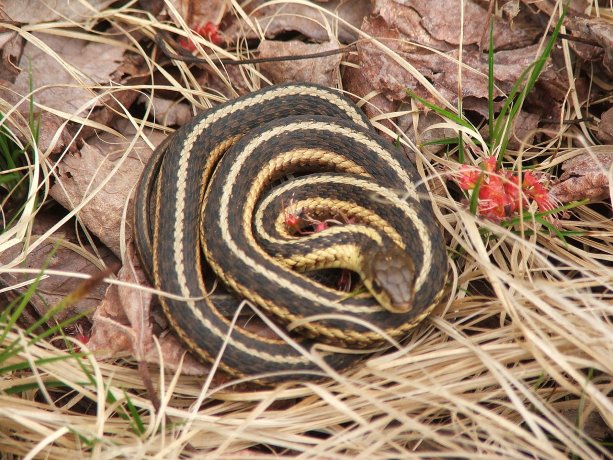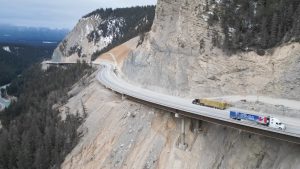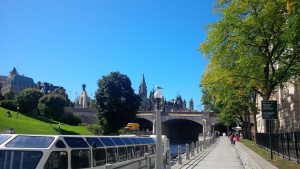Windsor, Ont.’s $1.4 billion Herb Gray Parkway that opened a year ago and is scheduled to connect to a new bridge to the United States in 2020, was precedent-setting because of how the construction preserved endangered wildlife.
The Parkway’s 11 kilometre footprint cut through former urban and rural areas of west Windsor and neighbouring LaSalle, impinging on the area’s Carolinian Tallgrass Prairie, a collection of varied plants and animals unique to Canada, including nine of which are species at risk. Two are animals — the Butler’s Garter snake and Eastern Fox snake. Then there are seven plants — the Colicroot, Common Hoptree, Dense Blazing Star, Dwarf Hackberry, Kentucky Coffee-Tree, Willowleaf Aster and Eastern Prairie Fringed-orchid.
Accordingly, one of the first structures that went up before actual roadwork began in 2006 was a black geotextile fence that sought to keep snakes outside the construction footprint.
After that, a platoon of biologists went to work removing the snakes and tracking how they managed in their new, relatively adjacent, habitats.
"There’s not really any studies to date anywhere in North America or otherwise that have been able to look at snake behaviour in this much detail relative to the installation of a road," Megan Hazell, senior wildlife biologist with Amec Foster Wheeler, a consultant to the Parkway project, told attendees at a recent community meeting.
"That’s what we’ve been focused on for the past five years."
As many as 15 Parkway affiliated staff have been tracking hundreds of snakes every spring until fall — over 25,000 hours of collected data — with monitoring to continue for another five years.
People who build highways may not know a lot about snakes but even biologists had little data about these rare species, Hazell said.
"There hasn’t been a lot of money poured into snake research — that’s changing now," she explained.
So the scientists learned as they went along.
"We would find out things about how they (snakes) responded to the project and we would have to come up with ways to problem solve to make sure they were protected," she said.
Besides the geotextile fence, the researchers captured snakes in the construction footprint by using coverboards, under which snakes would gather.
They also found snakes in the foundations of homes that were to be demolished.
"Often we would find snakes laying eggs under the front doorsteps," Hazell said.
Researchers then surgically implanted hundreds of captured snakes with radio transmitters so they could be tracked.
Hazell said one of the things scientists learned was that snakes had "very strong fidelities" to their former homes.
For example, snakes removed from near the border of the construction footprint tended to cluster close to the fence outside the border. But the response of snakes removed from the centre of the footprint was mixed.
"It took them as little bit longer to adjust to their new habitat, they would explore for a while and sometimes they would try to get back into the construction site," Hazell said.
Despite the barrier fence the snakes would often find a way back through streams that were left unblocked to protect fish.
"We would have to relocate them again," she said. "Some snakes adjusted, some snakes did not."
Meanwhile, in their new habitats, biologists built shelters known as hibernaculum, which could be made of anything from split up concrete slabs to piles of logs and brush.
"That is some of the first documented use of some of these features which were designed just for this project," Hazell said.
Besides taking care of the snake species, endangered plants were also on the agenda.
Removing some 200,000 plants from the construction site was painstaking but has since proved rewarding, researchers said. The provincial Species at Risk (SAR) permit not only required the plants’ removal but their propagation elsewhere.
Teaming with partners like the Walpole Island First Nation’s Danshab Enterprises, plants were moved by hand. Seedstock was also collected and spread among 32 different restoration sites nearby or immediately adjacent to the Parkway.
Besides the tactile hand work of removing plants, several thousand square metres of sod mat were also dug up and transported offsite, salvaging 850 tonnes of high quality prairie soil.
"It was the first time that something like this had been done," said Season Snyder, a senior plant ecologist with Amec Foster Wheeler.
After five years of study the plant species seem to be doing well.
There are now over half-a-million plants at the restoration sites and species like the Colicroot, Dense Blazing Star and Willowleaf Astor are thriving, Snyder said.
Ongoing prescribed burns of the deep-rooted plants only aid in the effort.
The point has been reached where the Parkway’s snake fences are about to come down and the restorative sites will abut the construction footprint which includes a vast natural landscape, also of Tallgrass Prairie — some 100,000 trees and shrubs have or still are being planted — with walking and cycling trails alongside.
There’s also over the 11 elongated Parkway tunnels in what has been described as an overall state-of-the-art highway construction project.
The Herb Gray Parkway is the largest landscape undertaking for any provincial highway to date and the first to use only native species. The Tallgrass Prairie motif is also engraved on the road’s sound barriers and bridges for motorists travelling the route to see.











Recent Comments
comments for this post are closed